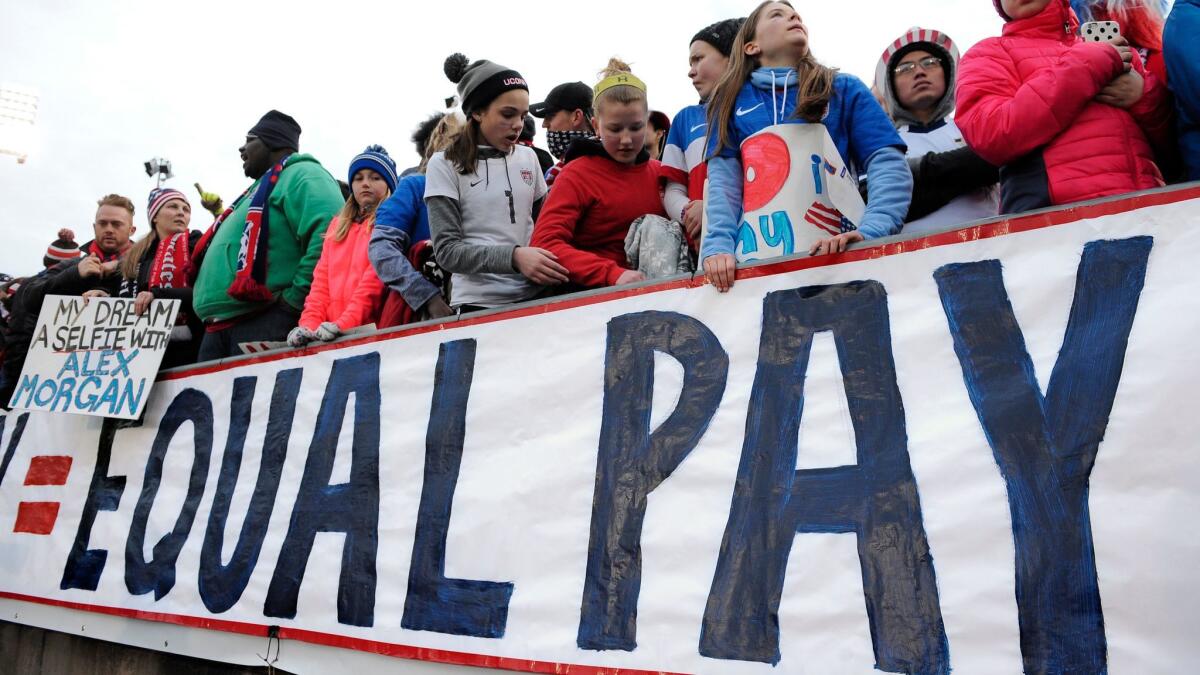Here’s why the push for pay transparency grows stronger — despite Trump

- Share via
Although the Trump administration last week halted an Obama-era rule requiring large companies to share data with the government about how they pay employees by race and gender, human resources experts and advocates for equal pay say it’s unlikely to slow the push toward pay transparency that employees, shareholders and local governments have demanded in recent years.
Increasingly, employees are turning to popular websites such as Glassdoor or Payscale to compare their salary data, and they expect companies to publicly say they pay men and women equally. Shareholders have pushed technology and financial services companies to release their gender pay gap statistics. More state and local governments have passed pay equity laws, some of which require state contractors to report data or certify they pay men and women the same.
“Our culture is moving toward greater pay transparency, and I don’t think you can unwind that clock,” said Fatima Goss Graves, chief executive of the National Women’s Law Center. “The White House’s effort to stop the rule is not going to stop the push for pay transparency that’s coming from employers or from shareholders. States are going to start stepping up and filling in the breach.”
Human resources experts agreed.
“The momentum is already there on pay transparency,” said Gail Greenfield, a principal at the consulting firm Mercer. “You can’t take that back.”
Greenfield said as shareholders have pushed for companies to disclose more about their equal pay practices — investors such as Arjuna Capital and Pax World Management have done so — a “peer effect” has inspired other companies to talk more openly about their pay gap.
The data, after all, are just a mouse click away for many employees with the expansion of Glassdoor and similar websites. Dawn Lyon, vice president of corporate affairs for the pay data site, said there has been “a sizable increase in employers hungry for information about how they make sure they don’t have a pay gap” over the last two years, with more than 3,700 adding an equal pay “pledge” to their company profile during that time.
“We’re seeing pay equality and commitments to pay equality really influencing employers’ brands,” she said. At a time with such low unemployment, “these are things that set companies apart.”
Brian Kropp, who leads the human resources consulting practice at CEB, says there’s been a striking uptick in companies rushing to analyze and understand whether they have a pay gap. In a recent survey CEB did of 78 Fortune 1000 companies, he said, 69% said they had launched a pay equity effort in the last two years. Although some of that rush has come from regulatory pressure, he said, “there’s also a broader debate within society about the unfairness of the gender wage gap,” and companies have felt compelled to respond.
Our culture is moving toward greater pay transparency, and I don’t think you can unwind that clock.
— Fatima Goss Graves, chief executive, National Women’s Law Center
Meanwhile, state-level regulations have emerged. At least five states or cities, according to the National Women’s Law Center, have some kind of equal pay certification or reporting requirement. Typically, the requirements apply to government contractors, although there is a pending bill in California focused on large employers more generally.
That could have a broader effect than in just those states or cities as large companies that do business in multiple jurisdictions often adopt practices more widely to keep things standard, Kropp said. “If you’re a large employer, you can’t treat it as a local initiative,” he said.
He also thinks local ordinances could proliferate: “I can guarantee you, now that the Trump administration has put a stop to this reporting, the legislators, the mayors, the state senators — those local jurisdictions — will start to pass their own regulations, their own laws, where companies will have to report their numbers.”
Still, halting the reporting rule at the federal level could hurt enforcement and accountability. When companies report they have virtually no gender pay gap, even if calculated from a sophisticated algorithm, that’s an aggregate number that may mask bigger gaps among more narrow job categories.
“There’s a big difference in what they report publicly and what they do internally,” Mercer’s Greenfield said. Many, she said, are working to rectify the gaps they find among individual jobs but are hardly going to include those gaps they discover in news releases.
Still, the demand from employees for more pay transparency is only expected to grow. Millennial employees, in particular, don’t see talk about salaries as taboo, Glassdoor’s Lyon said.
“The genie is out of the bottle, and it’s not going anywhere,” she said. “It’s what workers expect.”
McGregor writes a column analyzing leadership for the Washington Post.
More to Read
Inside the business of entertainment
The Wide Shot brings you news, analysis and insights on everything from streaming wars to production — and what it all means for the future.
You may occasionally receive promotional content from the Los Angeles Times.










